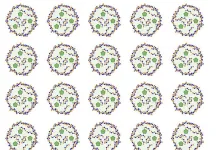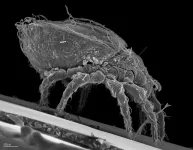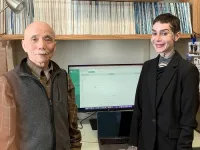(Press-News.org) Reston, VA (January 24, 2025)—The Society of Nuclear Medicine and Molecular Imaging (SNMMI) and the European Association of Nuclear Medicine (EANM) have issued a new procedure standard/practice guideline for the use of fibroblast activation protein (FAP) PET. Published in the January issue of The Journal of Nuclear Medicine, the procedure standard/practice guideline was developed to assist providers in recommending and performing FAP PET, as well as interpreting and reporting results of the imaging studies.
FAP is a transmembrane protein expressed on both cancer-associated fibroblasts and on normal activated fibroblasts involved in wound healing and tissue repair. FAP has long been a target for cancer therapy, but the development of FAP targeted radioligands has led to an increased interest in imaging FAP for assessment of cancer and other diseases.
“FAP PET imaging can be used for initial staging, re-staging, therapy response evaluation, and whole-body target expression assessment for therapy selection,” noted the authors. “This procedure standard/practice guideline provides referring physicians with the best available evidence to help them to deliver the best possible diagnostic efficacy and study quality for their patients.”
The procedure standard/practice guideline outlines several oncologic indications for FAP PET imaging, including gastro-intestinal adenocarcinoma, pancreatic ductal adenocarcinoma, esophageal, head and neck cancer, thyroid, lung, ovarian and breast cancers, as well as non-oncologic indications such as inflammation and fibrosis. In addition, it reviews the qualifications and responsibilities of imaging personnel, and presents standardized quality control/quality assurance procedures and imaging procedures for FAP PET.
“FAP PET is in its early days, and there will be significant changes to our understanding of its role as we learn more,” the authors said. “Moving forward, it is essential to establish well-designed prospective clinical trials to help elucidate the clinical role of FAP PET and lead to regulatory approval of these imaging agents. There will also be a need to better understand the clinical impact of more accurate disease detection and treatment response assessment. FAP PET is an incredibly promising imaging agent, and we look forward to its broad future in clinical practice.”
The full procedure standard/practice guideline for FAP PET imaging can be viewed on SNMMI’s website.
The authors of “SNMMI Procedure Standard/EANM Practice Guideline for Fibroblast Activation Protein (FAP) PET” include Thomas A. Hope, Department of Radiology and Biomedical Imaging, University of California San Francisco (UCSF), San Francisco, California, UCSF Helen Diller Family Comprehensive Cancer Center, University of California San Francisco, San Francisco, California, and Department of Radiology, San Francisco VA Medical Center, San Francisco, California; Jeremie Calais, Ahmanson Translational Theranostics Division, Department of Molecular and Medical Pharmacology, David Geffen School of Medicine, University of California Los Angeles, Los Angeles, California, and Jonsson Comprehensive Cancer Center, University of California Los Angeles, Los Angeles, California; Ajit H. Goenka, Department of Radiology, Mayo Clinic, Rochester, Minnesota; Uwe Haberkorn, Department of Nuclear Medicine, University Hospital Heidelberg, Heidelberg, Germany; Mark Konijnenberg, Radiology and Nuclear Medicine Department, Erasmus MC, Rotterdam, Netherlands; Jonathan McConathy, Department of Radiology, University of Alabama at Birmingham, Birmingham, Alabama; Daniela E. Oprea-Lager, Department of Medical Imaging, Radboud University Medical Center, Nijmegen, The Netherlands; Laura Trimnal, Department of Radiology, San Francisco VA Medical Center, San Francisco, California; Elcin Zan, Department of Radiology, Cleveland Clinic, Cleveland, Ohio; Ken Herrmann, Department of Nuclear Medicine, University Hospital Essen, University of Duisburg–Essen, Essen, Germany, and German Cancer Consortium, Partner Site University Hospital Essen, and German Cancer Research Center, Essen, Germany; Christophe M. Deroose, Nuclear Medicine, University Hospitals Leuven, Leuven, Belgium, and Nuclear Medicine and Molecular Imaging, Department of Imaging and Pathology, KU Leuven, Leuven, Belgium.
Visit the JNM website for the latest research, and follow our new Twitter and Facebook pages @JournalofNucMed or follow us on LinkedIn.
###
Please visit the SNMMI Media Center for more information about molecular imaging and precision imaging. To schedule an interview with the researchers, please contact Rebecca Maxey at (703) 652-6772 or rmaxey@snmmi.org.
About JNM and the Society of Nuclear Medicine and Molecular Imaging
The Journal of Nuclear Medicine (JNM) is the world’s leading nuclear medicine, molecular imaging and theranostics journal, accessed 15 million times each year by practitioners around the globe, providing them with the information they need to advance this rapidly expanding field. Current and past issues of The Journal of Nuclear Medicine can be found online at http://jnm.snmjournals.org.
JNM is published by the Society of Nuclear Medicine and Molecular Imaging (SNMMI), an international scientific and medical organization dedicated to advancing nuclear medicine, molecular imaging, and theranostics—precision medicine that allows diagnosis and treatment to be tailored to individual patients in order to achieve the best possible outcomes. For more information, visit www.snmmi.org.
END
JNM publishes procedure standard/practice guideline for fibroblast activation protein PET
2025-01-24
ELSE PRESS RELEASES FROM THIS DATE:
What to do with aging solar panels?
2025-01-24
The National Science Foundation Convergence Accelerator Program has granted $5 million dollars to Phase 2 of the project “Securing critical material supply chains by enabling phOtovoltaic circuLARity (SOLAR).”
SOLAR’s goal is to proactively ensure circularity of solar panels by providing solutions to barriers throughout the end-to-end supply chain. The intent is to make solar panels recyclable and find a solution to remanufacturing them at a competitive cost. Achieving this will help promote a clean and resilient energy system in the United States.
The three-year project is led by Battelle Memorial Institute ...
Scientists design peptides to enhance drug efficacy
2025-01-24
NEW YORK, NY, January 24, 2025 — A team of scientists has developed a groundbreaking approach using specially designed peptides to improve drug formulations. This innovative method significantly enhances anti-tumor efficacy, as demonstrated in leukemia models. The study, published in the journal Chem, was led by researchers at the Advanced Science Research Center at the CUNY Graduate Center (CUNY ASRC) and Memorial Sloan Kettering Cancer Center.
Drug delivery systems often face two critical challenges: poor solubility and inefficient delivery within the body. Many drugs do not dissolve well, making it difficult for them to reach ...
Collaboration to develop sorghum hybrids to reduce synthetic fertilizer use and farmer costs
2025-01-24
ST. LOUIS, MO, January 24, 2025 - A new collaborative research team of leading plant scientists are developing sorghums with nitrogen-saving traits by utilizing the genetic diversity of wild relatives to improve resilience and productivity for grain sorghum producers.
The project is part of a $38 million investment in nine projects by the U.S. Department of Energy, DOE, Advanced Research Projects Agency-Energy, ARPA-E, to develop advanced technologies for plants to increase nitrogen-use efficiency and reduce nitrogen pollution from U.S. bioenergy feedstocks.
Veena Veena, PhD, MBA, principal investigator and director of the Plant Transformation ...
Light-activated ink developed to remotely control cardiac tissue to repair the heart
2025-01-24
Researchers from Mass General Brigham and collaborating institutions have developed a non-invasive approach to manipulate cardiac tissue activity by using light to stimulate an innovative ink incorporated into bioprinted tissue. Their goal is to develop a technique that can be used to repair the heart. Their findings in preclinical models, published in Science Advances, show the transformative potential of non-invasive therapeutic methods to control electrically active tissues.
“We showed for the first time that with this optoelectronically active ink, we can print scaffolds that allow remote control of engineered heart tissues,” said co-corresponding ...
EMBARGOED: Dana-Farber investigators pinpoint keys to cell therapy response for leukemia
2025-01-24
Boston – Dana-Farber Cancer Institute researchers have identified factors that determine whether donor lymphocyte infusion (DLI), a standard therapy for patients with acute myeloid leukemia (AML) who have relapsed after allogenic hematopoietic stem cell transplant, will successfully move the patient into remission. The team identified that a key cell type in the DLI product and features of the tumor microenvironment in patients both play a role.
The findings were published in Science Immunology.
“Relapse of AML after stem cell transplant is a major challenge,” says first author Katie ...
Surgeon preference factors into survival outcomes analyses for multi- and single-arterial bypass grafting
2025-01-24
LOS ANGELES—January 24, 2025—In patients undergoing coronary artery bypass grafting (CABG), a novel analysis evaluating surgeon preference for multi- versus single-arterial grafting may help explain the differing results between prior retrospective analyses and randomized controlled trials regarding long-term survival.
A study presented this week at The Society of Thoracic Surgeons’ 61st Annual Meeting explores findings in more than a million U.S. Medicare beneficiaries who underwent CABG from 2001 to 2019. The researchers found that patients who received multi-arterial grafting (MAG) had improved survival over those who ...
Study points to South America – not Mexico – as birthplace of Irish potato famine pathogen
2025-01-24
Call it a mystery solved.
North Carolina State University researchers firmly point the finger at the South American Andes Mountains as the place where the Irish potato famine pathogen, Phtytophthora infestans, originated.
In a wide-ranging study of the genetic material found in P. infestans and other members of the Phytophthora species, the NC State researchers provide more evidence that P. infestans spread from South America to North America before wreaking havoc in Ireland in the 1840s. The pathogen still causes late-blight disease on potato and tomato plants around the world.
Much ...
VR subway experiment highlights role of sound in disrupting balance for people with inner ear disorder
2025-01-24
The vestibular system is a network of organs in the inner ears that detects the motions and position of the head. The brain uses this information, along with inputs from the eyes and joints, to maintain the body’s balance.
Visual information has long been proven to affect balance—for example, strobe lights and swirling images can cause instability—but a new study published in PLOS ONE shows that sounds can also be a disruptive factor for those who have vestibular hypofunction, a vestibular system disorder resulting in impaired balance.
“People with vestibular hypofunction have ...
Evolution without sex: How mites have survived for millions of years
2025-01-24
In collaboration with colleagues from international partner institutions, researchers at the University of Cologne have investigated the asexual reproduction of oribatid mites using genome sequencing techniques. They show that the key to evolution without sex in oribatid mites may lie in the independent evolution of their two chromosome copies – a phenomenon known as the ‘Meselson effect’. The research team identified various mechanisms that may contribute to the genetic diversity of the chromosome ...
U. of I. team develops weight loss app that tracks fiber, protein content in meals
2025-01-24
URBANA, Ill. – Many people struggle to maintain a healthy weight, and choosing the optimal meals for weight loss can be challenging. A research team at the University of Illinois Urbana-Champaign has developed a weight management program that helps individuals plan meals with the assistance of a web application and support from a registered dietitian. In a new study, they discuss the app’s features, development, and implementation.
“The overall goal is to develop an online weight loss program that can be used as prevention as well as treatment in a clinical setting,” said co-author Manabu Nakamura, associate professor in the Department of Food Science ...





